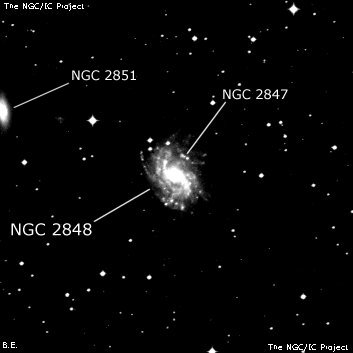
William Herschel discovered NGC 2848 = H III-488 = h587 on 31 Dec 1785 (sweep 503) and logged "vF, cL, gvlbM, near 3' long and above 2' broad, preceding a pB star." His position was 16 tsec too far west and 1' north. On 16 Dec 1827 (sweep 111), John Herschel recorded, "vF; L; E nf to sp; lbM. It is 9.5 sec preceding a * 11m and south of the star."
300/350mm - 13.1" (12/22/84): fairly faint, moderately large, very diffuse, slightly elongated SW-NE, very weak concentration.
400/500mm - 17.5" (3/28/87): fairly bright, moderately large, bright core, faint halo 3:2 SW-NE. A mag 12 star lies 2.8' NE of center. Forms a pair with NGC 2851 5.5' ENE.
900/1200mm - 48" (2/20/12): bright, large, oval 3:2 SW-NE, contains a relatively large, bright core that increases to the center. A spiral arm is attached on the west side of the core and it sweeps around the galaxy clockwise, heading south and then sharply bending east before dimming out on the southeast side of the halo. But an apparently detached section of the arm reappears on the east side heading north towards two mag 14/15 star at the NE edge. A mag 16.5 star is superimposed on the NW side (0.6' from center) and attached to this star is an extremely faint HII knot. The combination of star + knot was likely recorded by Mitchell using Rosse's 72" as a "faint knot north-preceding" and it received the designation NGC 2847. A mag 12 star lies 2.7' NE and NGC 2851 is 5' NE.
Notes by Steve Gottlieb